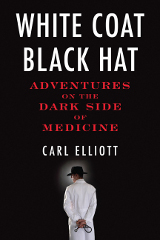The Ethicator Interview: Michael Palmieri and Donal Mosher
Michael Palmieri and Donal Mosher’s new film, Off Label, premieres at the Tribeca Film Festival on April 19, then plays at HotDocs in Toronto the last weekend of April. We spoke by email.
E: Congratulations on scoring an interview with the Ethicator. Please state your name, your occupation, and the product you are trying to sell us.
MP/DM: We are documentary filmmakers, we made a film called “Off Label“, a new film premiering at the Tribeca Film Festival on April 19th in their competition program. So I guess this is the “product we are selling”.
The film examines life on the margins of the medicalized landscape of America. Human guinea pigs, army medics with PTSD, an anarchist labor organizer on Adderall, a drug detail man turned medical anthropologist studying the effects of Paxil on chimps at the Milwaukee zoo, train-hopping newlyweds on a litany of test medications, and a woman who lives in the back of a Bigfoot museum on 20 separate meds for bipolar schizophrenia are some of the subjects covered in the film. So I guess at the very least, Bigfoot is in it.
E: Doctors and drugs and bad guys. I get it. Now, does my name appear in the credits?
MP/DM: No, it doesn’t. Actually, we took a closer look at your website and it seems that you actually know Carl, but I get the feeling you don’t like him very much. Did you know we were heavily inspired by his work in the making of this film? Is that a problem?
E: “His” work? That’s what he told you? Nothing to do with me? Actually, no, it’s not a problem. I’ve moved on.Â
So, just for the sake of argument, what part of “Carl’s” work was it that supposedly inspired you? Was it “his” philosophical ideas? Or was it his more recently acquired, nearly sociopathic resentment of the pharmaceutical industry and anyone who works for a living? Or could it have been his knack for stealing other people’s ideas and making money off them? Does plagiarism inspire you?
MP/DM: I hardly consider Carl’s work “plagiarism”, nor our interest in expanding upon the subject in his article through a documentary film, but given your tone, it seems like anything’s game. “Better Than Well” was a huge inspiration on the film, as well as “White Coat, Black Hat”, the book you’re promoting on your site that you seem to love so much. But Carl’s article in the New Yorker, “Guinea-Pigging” was a sort of launching-off point for us and began us down a long and winding path examining medicine on the margins. A character in the film, Robert Helms, is actually in that article.
Say, I notice you designed the whitecoatblackhat.com web page in the Vegur font, one of those go-to fonts everyone seems to be using these days. Did you know it’s a blatant ripoff of the Myriad font? And lemme guess, you’re probably using the Word-Press template for the site. How… original.
E: Oh, right, that’s it! I forgot to invent a new font for the website! Hey, I bet that’s why Carl hates me. It’s because I’ve been sticking with standard-issue fonts. That must be such a drag for him after paying — how much for his website again? — oh, yeah. NOTHING. Whatever.
But enough about me. I notice the two of you collaborated on this Bigfoot movie of yours, and that you’ve also done a couple of projects together in the past. Yet interestingly, I’m only hearing from one of you (Michael). My question is: Does either one of you ever feel the urge to hog all the glory, or maybe steal the other person’s ideas? For example, have you ever collaborated with one another via email for months on end, only to see the other person run off with a script, make a pile of money and give you no credit? Then, maybe coming back later, saying something like, “hey, buddy, how about taking a volunteer job as key grip? It doesn’t pay shit, but it could be your big chance!” Anything like that?
MP/DM: “We” collaborate together on all of our documentary work, it started with “October Country“, a doc that came out in 2009 that also features witches, ghosts and gun factories, in addition to the social ills that plague the working poor in Central New York. Sadly Bigfoot didn’t make it into that film, he ended up on the cutting room floor after a long argument about the direction of the content of that film. But “we” enjoy working with one another because we come at things from different perspectives, often fighting for weeks on end over an edit only to find out the compromise we reach is almost always better than our individual take on things. Donal’s background was as photographer and writer first and foremost, and I’ve been a filmmaker and spotlight-craving whore my whole life, so that’s probably why I chose to write back to you first. Just think of me as the documentary version of Sally Field accepting her Academy Award in this clip at the 3:20 mark. Donal cares less for these non-productive interviews, he has busy photo career, sort of like Faye Dunaway in The Eyes of Laura Mars.
But just because our responses are coming from my email address doesn’t mean we aren’t both poring over your questions/attacks at length. Suffice it to say Donal finds your tone really acerbic, and he seriously questions your intentions at all in interviewing us. He did notice that you ducked our inquiry on the all-too-overused word-press template design for whitecoatblackhat.com. Don’t think WE aren’t both waiting to hear back about that.
E: We’re back to that WordPress template again? OK, once more, with feeling: I don’t get paid for this shit. Sometimes, those of us in the creative professions are asked to create something out of nothing. Some people buckle under the challenge, but the more visionary types will take ordinary, freely available materials from our everyday life and impart new meaning to them. To wit: My brother bullies me into setting up a promotional website for a budget of jack shit. I then take an ordinary, colorless WordPress theme and transform it into a viral sensation, the bioethics world’s most successful blog. That’s what other people call resourcefulness. Innovation. Thinking outside the box. Not that I really expect you to understand my process, but let’s just say I can’t just cut to a car chase or throw in some fancy CGI whenever things get boring.
Now, if YOU’re done interviewing ME: I think my readers will want to know about your Bigfoot movie. Why Bigfoot, and why now? Are you doing voiceover narration like Leonard Nimoy , or acting it out like Andre the Giant did? And why the medication angle? Was it Carl’s idea to medicate Bigfoot? Because it doesn’t sound ethical to me.
MP/DM: Car chases? Fancy CGI? We make documentaries on shoestring budgets, so we also have to be resourceful in our creative strategies. In fact, we have a Bigfoot re-enactment in this film but we couldn’t get Andre the Giant to play Bigfoot, so we did it from Bigfoot’s POV instead. No one can replace Andre, and Bigfoot deserved the best to bear his likeness, so we came up with that solution. Ultimately our credibility as filmmakers rests on the effectiveness of such re-enactments so we had to tread carefully down that road. But it is really insightful that you mentioned the Andre the Giant clip from the Six Million Dollar Man. The subtle use of slow-motion and sound effects was way before its time. These kinds of artistic strategies are instrumental for us in our work to draw an audience in with the limited material we gather in the field. See, Ethicator, it seems like we have more in common than I actually thought. We’re both resourceful. I can’t ask Donal whether he likes this Steve Austin reference or not because he’s off photographing the working class for a hard-hitting story about those who can’t afford designer jeans, but he said he’d be back in a few minutes.
As for the medication angle, the whole film was actually proposed to us by our producers, Anish Savjani and Vincent Savino of filmscience. (filmscience.com) Â They became interested in a story about human guinea pigs by Josh McHugh in Wired Magazine called “Drug Test Cowboys“, as well as the article that Carl wrote for the New Yorker. We ended up reaching out to Carl and he kindly met up with us in Minneapolis. We kind of hit it off instantly, and spent numerous hours at The Bad Waitress discussing the possibilities of shaping a different kind of film about health care where everyone is implicated – not just the drug companies, but drug sales agents, doctors, and especially patients. The problem of overmedication is systemic; we don’t aim to say all that drugs are bad, because we need medicine, but there are certain aspects of the drug industry that are dubious, where ideas and actions collide in complex and associative ways that a consumer may not necessarily be aware of. We think that’s worth exploring in a film. We’d even go so far as to say it’s the ethical thing to do.
E: OK, I think I’m understanding now. You made a Bigfoot movie, but couldn’t do any CGI or car scenes, so you just got a tall guy to walk around with a camera. Fine. But out of respect, could you at least call him a Sasquatch? Bigfoot is the racist term, and it’s making me uncomfortable.
Also, like Carl, you think people take too many pharmaceuticals. Is that why you’re medicating a Sasquatch instead? What kinds of drugs did you test, and did Carl design the research protocol? As an ethicist, I find that deeply troubling. I could really nail Carl over that one.
MP/DM: Wait, what? We weren’t testing any drugs, and we weren’t medicating Sasquatch either. We made a film about people who are implicated by the pharmaceutical industry in numerous ways. Carl didn’t have anything to do with testing anything! What’s your beef with this guy?
E: OK, so now you’re confusing me. First you’re telling me about a racist, drug-addled Sasquatch movie, and now it’s just a movie about doctors and drugs and bad guys. It all sounds hard to follow. No offense, but I think you need to work on this interviewing thing. Focus your message, is all I’m saying. Just some friendly advice.
That said, have you ever thought about making a movie about a Sasquatch on psychoactive drugs? Maybe with social anxiety meds? If you do make this movie, I would expect you to put my name in the credits like you did for Carl.
MP/DM: We’d very much like to make that film. Do you have any thoughts on how we could convince Bigfoot to try Risperdal?
E: Again, Sasquatch. Bigfoot is the racist term.
I am not sure about administration, but in my professional opinion, an anti-psychotic would likely make the Sasquatch more docile and less socially phobic. Also, unfortunately, less skilled at karate.
Still, let’s not put the cart before the horse. There’s a lot of legwork to do. For a project like this, you’ll need a media-savvy bioethics geek, somebody who can navigate the waters between Big Pharma and Big Ethics. Just blue-sky thinking here, but I believe we’ll need to fire up a mission statement, bang out some research protocols, get an IRB, the works. As a crossover type, I think I could work that out for you, but we’ll need some face time to iron out the numbers.
MP/DM: Sounds like you’re gonna get a producer credit for sure.
E: Thank you. Carl can be the key grip, if he’ll work for free.

